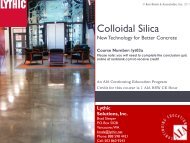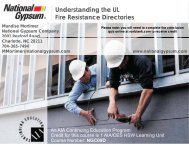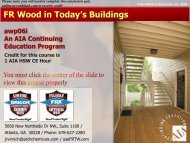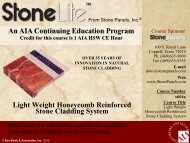Self-Adhered Modified Bitumen Technology - Ron Blank ...
Self-Adhered Modified Bitumen Technology - Ron Blank ...
Self-Adhered Modified Bitumen Technology - Ron Blank ...
- No tags were found...
Create successful ePaper yourself
Turn your PDF publications into a flip-book with our unique Google optimized e-Paper software.
© <strong>Ron</strong> <strong>Blank</strong> & Associates, Inc. 2013<strong>Self</strong>-<strong>Adhered</strong> <strong>Modified</strong><strong>Bitumen</strong> <strong>Technology</strong>Course #: PGI07CProvider: InfoSpec, Inc.An AIA Continuing Education ProgramCredit for this course is 1 AIA HSW CE HourSELF-ADHERED MODIFIEDreceive creditBITUMEN TECHNOLOGYPlease note: you will need to complete the conclusion quiz online at <strong>Ron</strong><strong>Blank</strong>.com toGlobalShield, Inc.320 Northpoint Parkway, Suite QAcworth, GA 30102www.xtraflexroofsystems.comToll Free: (800) 374-7663Phone: (770) 974-2499Fax: (770) 974-2723Questions? info@globalshield.us
An American Institute of Architects (AIA)Continuing Education ProgramApproved Promotional Statement:<strong>Ron</strong> <strong>Blank</strong> & Associates, Inc. is a registered provider with The AmericanInstitute of Architects Continuing Education System. Credit earned uponcompletion of this program will be reported to CES Records for AIA members.Certificates of Completion are available for all course participants uponcompletion of the course conclusion quiz with +80%.Please view the following slide for more information on Certificates ofCompletion through RBAThis program is registered with the AIA/CES for continuing professionaleducation. As such, it does not include content that may be deemed orconstrued to be an approval or endorsement by the AIA or <strong>Ron</strong> <strong>Blank</strong> &Associates, Inc. of any material of construction or any method or mannerof handling, using, distributing, or dealing in any material or product.
An American Institute of Architects (AIA)Continuing Education Program• Course Format: This is a structured, web-based, self study course with afinal exam.• Course Credit: 1 AIA Health Safety & Welfare (HSW) CE Hour• Completion Certificate: A confirmation is sent to you by email and you canprint one upon successful completion of a course or from your<strong>Ron</strong><strong>Blank</strong>.com transcript. If you have any difficulties printing or receivingyour Certificate please send requests to certificate@ronblank.com• Design professionals, please remember to print or save your certificate ofcompletion after successfully completing a course conclusion quiz. Emailconfirmations will be sent to the email address you have provided in your<strong>Ron</strong><strong>Blank</strong>.com account.
Course DescriptionThis course explores modified bitumen membranes for roofing with anemphasis on self-adhered applications. Gain knowledge on thecomposition, certification standards, and installation process of selfadheredmodified bitumen membranes as well as their limitations andadvantages.
Learning ObjectivesBy completing this course, the design professional will be able to:• Compare and contrast traditional SBS and APP membranes with selfadhered membranes in terms of project installation, risk, and cost• Identify the hazards and drawbacks of traditional hot mopping, coldprocess, and open-flame torching installation methods• Explain proper installation techniques for self-adhered membranes interms of safety and optimal project performance• Discuss project factors and considerations that may impact theinstallation and performance of self-adhered systems positively ornegatively
Introduction• <strong>Self</strong>-<strong>Adhered</strong> membranes have been in the roofing marketplace forover 10-years, but recent marketplace trends and productimprovements have led to a growth in their use. Contractors areadopting <strong>Self</strong>-<strong>Adhered</strong> membranes since they are much less laborintensive to install than traditional bituminous systems. InsuranceCompanies and Building Owners are advocating their use because noopen flame devices such as kettles or torches are required.• <strong>Self</strong>-<strong>Adhered</strong> membranes are available in the same types of base, plyand finish cap sheets as traditional SBS and APP membranes,including highly reflective surfaces which qualify for the LEED program.<strong>Self</strong>-<strong>Adhered</strong> membranes lend themselves to constrained installationswhere access, noise, and indoor air quality are a concern.
What is <strong>Modified</strong> <strong>Bitumen</strong>?• Low Slope asphaltic roofing istraditionally applied with hot oxidizedasphalt and plies of roofing felts tomake a “Built-up Roof”• <strong>Modified</strong> <strong>Bitumen</strong> membranes aremade by adding polymer modifiers(APP or SBS) to add durability andelongation properties to create animpermeable roofing membrane• <strong>Modified</strong> <strong>Bitumen</strong> roofing systemstypically consist of two or more plies ofmodified bitumen base, ply and capsheets. In some assemblies, modifiedmembranes are installed overtraditional non-modified asphalt baseplies.
Why we Modify AsphaltModifiers Improve Asphalt by Expanding Service Range0°F(Straight Run)200°F0°F (Blown)200°F0°F (Best of both worlds!) 200°FService Temperature Range
Evolution of <strong>Modified</strong> <strong>Bitumen</strong> ApplicationHot mopping of built-up roof (BUR) felts has been around since the 1800s.<strong>Modified</strong> <strong>Bitumen</strong> membranes were introduced in the 1960s. The first SBSsheets were installed with hot mop application. The APP sheets wereinstalled with torch application only. As the products were improved, newapplication techniques were developed. Cold process adhesives wereintroduced by the coating industry in the 1970s. <strong>Self</strong>-adhered membraneswere introduced by the roofing industry in the late 1990s.
Q: Why do we like Mod Bit Membranes?A: Multiple Application Techniques• <strong>Modified</strong> <strong>Bitumen</strong> (or mod bit for short) roof products have manyapplication techniques. This flexibility has provided a great success inthe roofing market place.• SBS membranes can be installed by hot mopping asphalt, using coldprocess adhesives, open-flame torching, or self-adhered membranes.
Q: Why do we like Mod Bit Membranes?A: Multiple Application Techniques• APP membranes can be installed in only three ways. The vast majorityare installed by open-flame torch. Cold process adhesives can be usedon sand-backed sheets. <strong>Self</strong>-adhered sheets are the third option.• The melt point of APP is higher than SBS and would require heatingmopping asphalts near or above their flash point.
Conventional Mod Bit Installation• Conventional <strong>Modified</strong> <strong>Bitumen</strong> installation requires mopping hotasphalt, solvent-based cold process adhesives, or open-flame torchingwhich leads to fumes, odors, VOC, and safety issues all real orimagined.• Many of the issues facing the applicationtechniques of modified bitumenmembranes are backed by realscience while other issues suchas health concerns may beperpetuated by undeservedreputation.
Industry Trends• Hot mopping and torching modified bitumens presents problems due tothe use of 450 degree asphalt or open-flame torching. Careless use ofthese techniques has led to fire and costly damages. Many buildingdepartments and insurance companies have mitigated this risk bybanning these practices.• Cold-process adhesives present an interesting alternative, but justbecause it’s cold doesn’t mean there is no risk involved.• The skill required to install a bituminous roof system is a higher levelthan a single-ply system. Finding good labor has been an increasinglydifficult task for contractors.• Asphalt fumes from kettles have led to environmental regulation,banning their use in several jurisdictions.
Industry TrendsWhen an asphalt kettle such as the one pictured here is placed at a jobsite, the contractor is showing the owner “I don’t care about good roofingpractice.” Accidents, misuse, and isolated bad roofing practice have led toan overall image problem that the entire industry must deal with.
The newest and fastest growing segment of modified bitumenapplicationSELF-ADHEREDTECHNOLOGY
Membrane Trends<strong>Self</strong>-adhered modified bitumen membranes can offer solutions to many ofthe issues facing the traditional installation practices. They are very easy toinstall with simple tools, so it is easy to train a workforce. There are nofumes and minimal odor associated with the installation. Fire is preventedsince there are no open flames or hot asphalt kettles. All of theseimprovements result in overall safer installation.
<strong>Self</strong>-<strong>Adhered</strong> Products – Commercial• <strong>Self</strong>-adhered modified bitumen roof systems are designed to functionexactly like the systems installed by traditional methods. Similar winduplift performance and fire resistance can be expected. The basesheets and cap sheets have been developed from the products in themarket place for over forty years.• <strong>Self</strong>-<strong>Adhered</strong> Membranes come inseveral configurations to functionas waterproofing membranes:– Base sheetsOne or more layers functioningas redundant plies– Cap SheetsFinal wearing surface
<strong>Self</strong>-<strong>Adhered</strong> Products – Residential• <strong>Self</strong>-adhered modified bitumen underlayments are considered anupgrade over roofing felts. Many areas of the country use them for icedam protection under shingle roofs. Some southern climates mayenclose the entire roof deck with self-adhered underlayment to work asa moisture barrier. Special formulations of underlayments have beendeveloped for high temperature applications under metal roofing. Payparticular attention to the temperature formulation for your metal roof.• Fabric facers came into the marketin the mid 2000s for foamappliedroof tile. This applicationtechnique is specific to theunderlayment and the foam used.Check your product literature formaterial compatibility.
Product Configurations• <strong>Self</strong>-adhered modified bitumen membranesresemble their traditional cousins. SBS or APPmodified asphalt is used as the water proofingcomponent. Polyester or fiberglass reinforcementact as the “carrier” of the asphalt. This is similar tothe concrete contractor installing wire meshbefore the concrete is poured for a sidewalk.• Smooth surface sheets are typically used as baseor ply sheets but can be coated or surfaced foruse as a finished cap sheet. Traditional roofinggranules or reflective films are commonly used asfinal surfacing to provide UV resistance, fireresistance and color. Steep slope underlaymentsare commonly finished with granules, fabrics orfilms depending on intended use (e.g. foamapplied tile, metal, shingles).
StandardsASTM Standards• ASTM has developed the following the standards to address performancecriteria for the following product configurations including the last standardwhich includes the nail sealability of modified bituminous sheet materials toensure water tightness when the membrane is used in a mechanicallyfastened system.– ASTM D 6222 specifies APP membranes with polyester reinforcement.– ASTM D 6164 specifies SBS membranes with polyester reinforcement.– ASTM D 6163 specifies SBS membranes with fiberglass reinforcement.– ASTM D 1970 addresses steep-slope underlayment applications for adhesionand nail sealabiltiy.
StandardsICC Acceptance CriteriaICC has developed two Acceptance Criteria to capture <strong>Self</strong>-<strong>Adhered</strong>membranes for product configuration and performance in relation to thebuilding code:• AC 75 – Roof Covering Systems• AC 48 – <strong>Self</strong>-<strong>Adhered</strong> Roof Underlayments for Use as Ice Barriers
Performance<strong>Self</strong>-<strong>Adhered</strong> Membranes have high wind uplift and fire resistance to adapt toalmost any project scenario in an equivalent application to hot mopped, coldprocess, or torched installations, performing very close to traditional appliedmodified bitumen membranes:• Wind Uplift• Fire– FM 1-345 assemblies– Miami-Dade -315psf– UL Class A
Performance• Many local building codes require the use of highly reflective roof materialsas part of “green” initiatives. Reflectivity and Emissivity combined to have acooler roof surface and hence a cooler building interior which allows HVACsystems to operate more efficiently.• The final surfacing of several self-adhered membranes are available withwhite granules or white films to provide high reflectance and high emissivitythat comply with:– Energy Star– CRRC– California Title 24
How does it Adhere?All self-adhered membranes are manufactured differently from traditionalmod bit membranes to provide “tack” and eventual adherence to similarperformance to traditional application methods up to FM 1-345 for a 2-plyinsulated system over concrete deck
How does it Adhere?• The adhesive to make modified bitumen membranes “stick” isaccomplished by one of two methods:– The most basic approach is to add a tackifier to a traditional sheet that willactivate the adhesive process when the release film is removed.– The second method is to apply a self-adhering compound to the undersideof the reinforcement carrier.• Both methods require the heat of the sun for warming the system aswell as rolling the membrane with a weightedroller to ensure a proper bond. You cannotsimply remove the backing like a bumpersticker and expect it to stay in place.• These are not “peel-and-stick” membranes ascommonly incorrectly categorized.
Release Films• All self-adhered products have the adhesivebacking protected with release films. Thesepolyethylene films are coated with silicone toallow for easy removal during installation. Properstaging of the job and having crew members withspecific roles will facilitate efficient operations.One of the biggest pitfalls is not removing all ofthe release film. While it sounds obvious, makesure the entire film backing is removed, leavingno residual film, to allow for proper adhesion.Once the film is removed, have a plan forcollecting the waste so the release film does notbecome airborne.• Because the films are coated with silicone, theyare unfortunately not recyclable. Please disposeof the films properly.
Innovations<strong>Modified</strong> bitumen membranes have selvedge edges or require end-lappreparation. To make the installations faster and trouble free, manymanufacturers have added granule-free areas to facilitate easy seaming ofthe membrane. Knowing full roll installation will not always be realistic, endlaps can be prepared for splicing by embedding granules with heat or usingmodified bitumen roofing cement.NO YES !
BoxesAlmost all <strong>Self</strong>-<strong>Adhered</strong> product is boxed – WHY?• <strong>Self</strong>-adhered products are traditionally boxed instead of bound by tape.The boxes protect this more sophisticated product during shipping andstorage on the roof. Leave the rolls in the box until ready for use. Theboxes act as insulators from the cold and protection from the sun. Theyessentially provide shade.
Boxes• Unbox the rolls as they are installed about five rolls at a time to relaxthe sheets and warm them with the heat of the sun. Continue stagingthe installation with five rolls ready to be installed. If the rolls becometoo hot due to premature exposure, getting the release film off may bean issue.• Collect your boxes to recycle as you would cardboard.
Installation TipsA few tips and tricks can make all thedifference in obtaining a successfulinstallation:• Product Handling – how you storethe product prior to installation• Adding heat or adhesives – how toget the desired adhesion• Proper sequencing of work –planning the job for efficientinstallation• Rolling – heat and pressure arerequired to complete the adhesiveprocess
Installation Tips• This picture shows the properstaging of cap sheet installation byallowing five rolls to relax in theheat of the sun. Getting the rollsout of the box and in a flat planeallows the sheet to get rid of thememory of being rolled up. Thesun starts to warm the sheet tofacilitate the self-adhering process.• This is essential especially on coolmornings or under cloudyconditions. Even if it’s a warmsummer day, get your sheets out ofthe box and relax them for a leastfifteen minutes.
Installation Tips• <strong>Self</strong>-adhered membranes achievemaximum initial adhesion wheninstalled in warm, sunny conditions• Refer to manufacturer guidelinesfor installation recommendationsduring cold temperatures
Installation TipsMoving the roll into proper position is essential for a quality installation. Oncethe release film is removed, repositioning the sheet may be difficult if notimpossible. If needed, cut the sheet into smaller usable lengths. This isespecially essential on warm days and in steep-slope applications.
Installation TipsIt is important to remove ALL of the release film from beneath the sheet.Experienced installers will develop a work plan so this becomes an efficientoperation to allow removal and collect the waste film. Without all of the filmremoved, the wind uplift performance of the system can be compromised.
Installation TipsAfter the plys are installed, roll the roof with a weighted roller in the shortdimension of the sheet to remove air bubbles and start the bonding process.<strong>Self</strong>-adhered membranes bond by using the warmth of the sun and thepressure of the roller to start the molecular connection to adhere the plys. Aneighty pound linolium roller or a water filled landscaping roller are acceptabletools to use.Use 80# roller on the roof surface for all plies
Installation TipsWhen seaming the head lap, remove the film on the granule-free end for aproper bond. Use a hot air gun or modified bitumen roofing cement to ensureproper head lap installation between successive sheets.
Installation TipsA T-joint is the intersection of three ply sheets. The T-joint has the potential toallow water infiltration when not properly seamed. When encountering a T-joint,cut a 45 degree dog ear off the selvedge edge to provide a tapered intersectionof the three membranes. In addition, a small bead of modified bitumen roofingcement can be added, or use a hot air gun and a hand roller to bond.Place a “dog ear” cut at all T-joints
Installation TipsAfter all of the rolling is completed on the roof, hand roll head laps and sidelaps with a neoprene roller. This just makes sure the areas for water intrusionare properly bonded.
Installation Tips – Steep Slope<strong>Self</strong>-<strong>Adhered</strong> products do not adhere to fabric surfacing – just like granulepreparation, they need special attention. Seam the headlap of the membrane ina bed of modified bitumen roofing cement to insure a watertight bond.
Installation Tips – Steep SlopeTile stacking varies by underlayment product. Each product in the marketplacehas a specific maximum tile stacking pattern. The bundleing of the roof tileswhen they are delivered typically does not comply to the stacking pattern.Check the underlayment manufacturer’s approved pattern to prevent tile slides.
Installation TipsAs you can see from this image, a properly installed seam will be very difficultto pull apart. This process can be almost instantaneous on a warm day. Coolerdays may require additional rolling or the use of supplemental hot air gun toenhance initial seam adhesion.Final seam bond after rolling and heat
The following installations highlight the unique roofingsolutions that can be achieved with self-adhered membranes:CASE STUDIES
Case Studies<strong>Self</strong>-adhered modified bitumen roof systems can mitigate these common issuesassociated with a roofing project:• Continued Building Operations– Noise– Fumes– Roof-top traffic• Access• Aesthetics• Complimenting adjacent steep-slopes
Commercial Low-Slope Roof - RetailRoof applications such as shoppingcenters with frequent tenant finish out,multiple HVAC penetrations and otherrooftop equipment requiring frequentmaintenance and service work benefitfrom multi-ply, durable roof assemblies.<strong>Self</strong>-adhered installations will allow forminimal disruption to HVAC operationand building occupants through reducednoise and quieter interior environmentduring roofing operations.Park Collection Shopping CenterSarasota, FL - 2002
Commercial Low Slope Roof – High RiseHigh-rise reroofing presents manychallenges such as limited accessand difficult debris removal. A selfadheredsystem can be brought upthe freight elevator in boxes. Onlythe cardboard and release filmwaste goes back down. <strong>Self</strong>adheredmembranes have theadhesive built into the product, soyou do not need to transport hotasphalt or cold adhesive to the roof.This minimizes materials brought tothe roof and makes installationmore efficient.LaGorce Palace CondominiumsMiami Beach, FL - 2010
Commercial Low Slope Roof - OfficeThis government office buildingneeded to be re-roofed during thenormal course of business. <strong>Self</strong>adheredroof systems can provideminimal disruption to officeenvironments because they do notproduce a lot of noise duringinstallation or have hot asphalt kettlesthat can lead to sick buildingsyndrome.Chet Holifield Federal BuildingLaguna Nigel, CA - 2004
Commercial Low-Slope - HospitalRe-roofing of hospitals requires lowimpact and quiet environements.Again, self-adhered systems reducefumes that can be ingested into HVACsystems and are quieter during theirinstallation.In addition, hospitals typically haveseveral small roof areas. <strong>Self</strong>-adheredsystems are easier to transport tothese hard-to-access areas.St. Joseph HospitalTampa, FL - 2010
Commercial Low-Slope Roof - Hotel• Hotels are typically twenty-four seven operations. Re-roofing needs to be alow-impact operation so the hotel can stay in business. The quieterinstallation and reduction of fumes into HVAC systems is beneficial. Inaddition, very little equipment, if any, is required on the ground that couldimpact parking or other ammenities at the hotel.• Re-roofing with self-adhered membranes is more prevelant than with newconstruction because of the low-impact attributes of the installation.Prestige Mountainside ResortGolden, BC - 2008
Commercial Commercial Low-Slope Low-Slope Roof: Multi-family RoofHousingMulti-Family Housing<strong>Self</strong>-adheredroofing can beproduced in a widevariety of colors tocompliment specificarchitectural details.This roof membranewas produced withgreen granules tocompliment thegreen steep slopemetal roof in thebackground.Seaside Landing CondominiumsSunset Beach, NC - 2007
Residential Residential Steep-Slope/Low Steep-Slope/Low SlopeTransition Slope TransitionMany residential roofstransition from steepslopeto low-slopeprofile. <strong>Self</strong>-adheredmembranes come inmany granule colorsto match orcompliment shinglecolor.Private ResidenceColorado Springs, CO - 2010
Limitations of SA MembranesLimitations of SA MembranesTemperatureMaterial and substrate must be 40 withambient air temperature of 40 and risingNot a Peel and StickRolling each ply with a linoleum roller or80# landscape roller is essential of inter-plybond
Limitations of SA MembranesLimitations of SA MembranesRelax the SheetsMembrane to be used should be taken out ofthe box and laid out (potentially upside down)on the roof to warm upProper StorageLeave in box to insulate from heat, storeinside when temperatures get below 40
Advantages of SA MembranesAdvantages of SA MembranesEasy to use<strong>Self</strong>-<strong>Adhered</strong> membranes are quicker toinstall than conventional systems and usejust a few hand toolsSafe Application<strong>Self</strong>-<strong>Adhered</strong> membranes eliminate theneed for torching or mopping and eliminateopen flames
Advantages of SA MembranesAdvantages of SA MembranesWide variety of substrates<strong>Self</strong>-<strong>Adhered</strong> membranes can be usedwith numerous approved substrates, coverboards, and rigid insulationClean and neat applicationNo asphalt bleed-out or mess caused byhot mopping or displacement of coldadhesives
Advantages of SA MembranesAdvantages of SA MembranesEcologicalEnvironmentally friendly with minimalfumes, odor, container disposal,storage of flammables, and noiseInsurance friendlyMany roofers have enjoyed reductions ininsurance premiums by eliminatingkettles and torches
Summary• <strong>Self</strong>-adhered membranes have a unique and growing place in themod. bit. roofing world.• <strong>Self</strong>-adhered membranes have equivalent asphalt modifiers andreinforcement options found in traditional mod. bit. membranes whichlead to equivalent performance.• Proper installation techniques for self-adhered membranes differslightly from traditional mod. bit. installation methods. Many of thetechniques required for self-adhered roofing system installation aresimilar to that of single-ply roofing. Understanding these similarities isessential to project success.• Certain building types lend themselves to re-roofing with self-adheredmembranes, resulting in minimal disruption to daily buildingoperations during the installation process.
Course SummaryNow, the design professional will be able to:1. Compare and contrast traditional SBS and APP membraneswith self adhered membranes in terms of project installation,risk, and cost2. Identify the hazards and drawbacks of traditional hot moppingand open-flame torching installation methods3. Explain proper installation techniques for self-adheredmembranes in terms of safety and optimal project performance4. Discuss project factors and considerations that may impact theinstallation and performance of self-adhered systems positivelyor negatively
© <strong>Ron</strong> <strong>Blank</strong> & Associates, Inc. 2013<strong>Self</strong>-<strong>Adhered</strong> <strong>Modified</strong><strong>Bitumen</strong> <strong>Technology</strong>Course #: PGI07CProvider: InfoSpec, Inc.An AIA Continuing Education ProgramCredit for this course is 1 AIA HSW CE HourSELF-ADHERED MODIFIEDPlease note: you will need to complete the conclusion quiz online at <strong>Ron</strong><strong>Blank</strong>.com toreceive creditBITUMEN TECHNOLOGYGlobalShield, Inc. Toll Free: (800) 374-7663320 Northpoint Parkway, Suite QAcworth, GA 30102www.xtraflexroofsystems.comPhone: (770) 974-2499Fax: (770) 974-2723Questions? info@globalshield.us
















